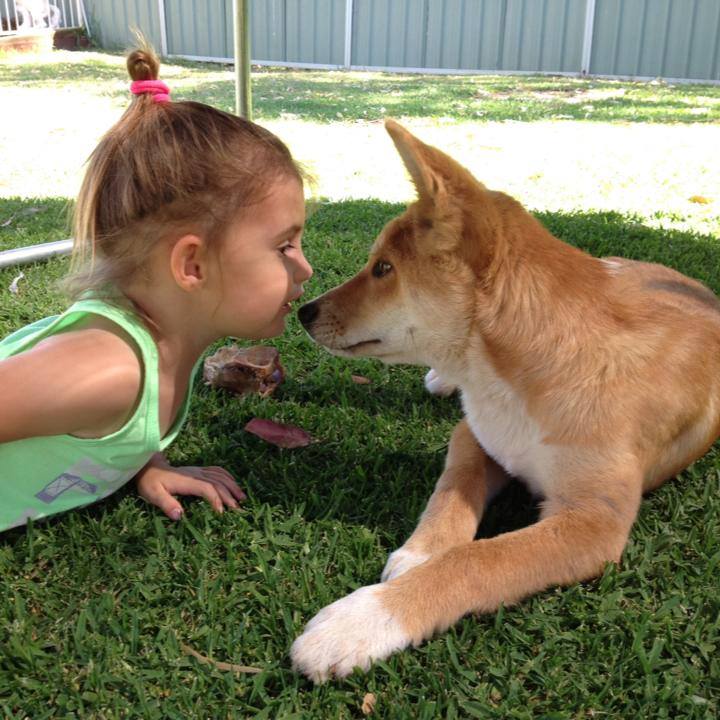DINGOES IN THE HOME
|
ARE THEY SAFE?
“Aren’t you worried it’s going to turn on you and your family one day?”, asked a group of people to a man who was holding a dingo pup in his arms at a public park. “No”, was the man's response. “I have seven dingoes, and I trust each one with my life. My family and friends all love my dingoes. One couple trust my dingoes with their little boy over their own Staffordshire bull terriers. The dingoes are allowed to play with the boy, the staffies are not.” Some people may be surprised by such a response regarding dingoes in the home. This may be due to a limited understanding of dingo nature, or the nature of natural species in general. Dingoes like all natural species are inherently timid and cautious. Their flight or fight response is predominantly to take flight– to hide or run away. Usually, a dingo would rather avoid conflict than engage in it. This natural response is based on survival strategy- to avoid a fight is to limit chances of injury, which may result in its own death. Being a natural species, dingoes do not have the same paranoia and instantaneous aggression that some dogs, like fighting breeds, sometimes possess. These breeds of dog were purposely bred for their aggressive responses to stimuli, which made them successful pit-fighting dogs. Comparatively, dingoes are far less confident. Their natural timidity causes them to respond sheepishly to new situations, crowds of people and excess noise. When faced with a situation they feel uncomfortable with, a dingo’s first response is often to run away. This is evident in the ratio of reported injuries across Australia incurred from dingoes compared to dogs. The ratio of dingo attacks versus dog attacks across Australia is 1:5000. For every injury caused by a dingo there are 5000 injuries from dogs, with 78% of dog-attack victims being members of the dog’s family or a family friend (Sydney Morning Herald, August 7 2013, Robert Zammit, Vineyard Veterinary Hospital). To answer the peoples' question at the park, the man's family, just like your family, are statistically 5000 times safer with the family-dingo then they are with the family-dog. TYPICAL TRAITS Captive-bred dingoes and wild-born dingoes (who have successfully adapted to domestic life) have some common traits:
FIGHT OR FLIGHT RESPONSE Like any animal, a dingo should not be forced into a situation that it feels uncomfortable with. If a dingo displays hesitation or discomfort, it should be left alone. If a dingo feels threatened and does not have a clear avenue to evade the situation (its flight-path is blocked), it may defend itself against the potential threat. Where a flight response in unavailable, a fight response is likely to follow. GAME DRIVE & HUNTING As an apex predator dingoes possess a naturally high game drive. This means they instinctively know that their food is sourced from other animals not from their food bowl. With their high intelligence and superior athletic abilities dingoes will hunt other animals for food. This is not a sign of aggression, nor does it typically pose a risk to their human owners. Some dingo owners allow their dingoes to fulfil this natural desire, just as Indigenous Australians had done for twenty millennia with the dingoes that lived in their camps. Dingoes are known to bring the animals they have caught to their human owners just like a cat may bring its owner a mouse. FENCING REQUIREMENTS
One of the many differences between dingoes, and normal canines, is their incredible physical capabilities. Dingoes are far more flexible in limb and hip movement than dogs. They can rotate their wrists and subluxate their hips. These adaptations aid hunting and moving through burrows. A dingo's skull is the broadest part of it’s anatomy. This assures the dingo that it’s body will follow it’s head through any obstacle. Dingoes can run 60km/hour, travel 40km per day, jump two meters high and successfully climb trees. While all of these aspects in the wild setting are extremely impressive, it also makes them escape artists in the domestic setting. Before rehoming a dingo into an environment, our adoption process involves several rounds of interviews to ensure the area is suitable and safe for a dingo. This includes thorough fence checks. Adoption applicants may be asked to upgrade their fencing before adoption if it is not suitable. This is to prevent the dingo from escaping, and potentially becoming injured in the man made world. Fencing protocols are as follows. Fencing must be a minimum of 2.1 meters in height, with a 45 degree return facing into the yard to prevent climbing. A return on the top of the fence will not be required if fencing is above 2.5 meters straight up. The base of your fencing also needs to secure, with no gaps or holes that could be used to wiggle through. At first this information does sound daunting but it can be achieved quite easily with ingenuity and family team work! Just over to the right you will see some example pictures from some of or past adopters. All upgrades done with love and care to ensure their new furry friend is safe and secure! |
One couple trusts my dingoes with their little boy over their own Staffordshire Bull The same dingoes who hunt with their owners can socialise well with strangers and dogs in public settings like dog parks. As highly intelligent animals, dingoes easily distinguish between 'friends' and 'food'. Their game drive does not make them inherently unpredictable or dangerous towards people. Care should be taken around animals such as rodents, cats, rabbits, poultry or livestock. Some dingoes have been trained to work with sheep and cattle, befriend cats, and even protect other pets. This can be achieved through exposure and training. As with all animals, no training is full proof and supervision is always recommended. WILD DINGOES Wild dingoes who do not have a relationship with humans may inquire if a human is a food source. Wild dingoes should always be treated with the utmost respect, just as if they are a lion in Africa, or a tiger in Asia- they are Australia’s equivalent. This is best achieved by not feeding wild dingoes, or approaching them in any instance. BEHAVIOUR WITH OTHER DINGOES & DOGS Dingoes have a strict hierarchy and may correct the behaviour of dingoes or dogs that disrespect them. This is not a sign of inherent aggression or instability. It is a sign of social structure and order, with the lead dingo educating the inferior dingo or dog on what is socially acceptable. During breeding season (March- August), female dingoes will typically become aggressive towards other females and desexed males. Male dingoes may become territorial or dog-aggressive once a female begins her cycle. Neutered dingoes may present similar behaviour at this time. Outside of breeding seasons dingoes tend to be calmer and socialise more successfully with other dingoes or dogs. It is advised to limit interactions with new dogs or new people during breeding season. OWNERSHIP COMPATIBILITY Captive-bred dingoes, or wild-born dingoes that have successfully adapted into domesticity often make enriching companions for those who understand their nature and natural desires. Dingoes are a unique animal and do not suit all people. Dingoes will flourish with owners who are sensitive, intuitive and possess a high degree of emotional intelligence and awareness. When caring for dingoes, a person should be patient and understand that a dingo is a highly wilful and intelligent animal that has special needs that are different to a dog or cat. For more information about caring for dingoes, please see our other articles in the Dingo Care section. |











